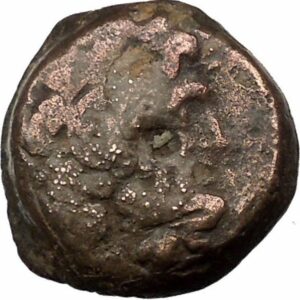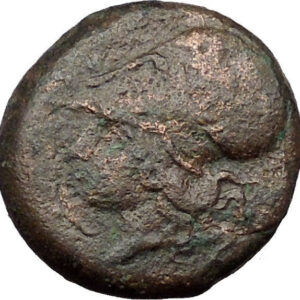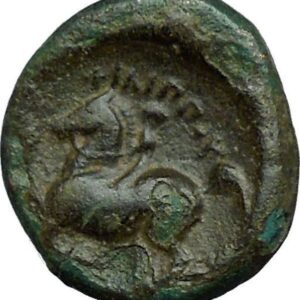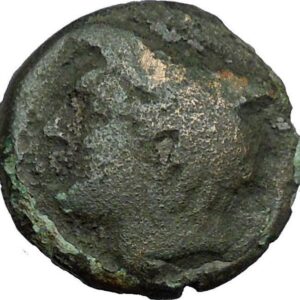|
Greek city of Thasos, an Island off Thrace
Bronze 20mm (5.75 grams) Struck circa 150-42 B.C.
Reference: HGC 6, 364; Le Rider 60-62
Bust of Artemis right, wearing stephane, bow and quiver over shoulder.
ΘΑΣIΩΝ, Hercules standign right, firing bow.
Thasos, an island in the north of the Aegean sea, off the coast of Thrace and opposite the mouth of the river Nestus. It was at a very early period taken possession of by the Phoenicians, on account of its valuable gold mines. According to tradition the Phoenicians were led by Thasus, son of Poseidon, or Agenor, who came from the East in search of Europa, and from whom the island derived its name. Thasos was afterwards colonized by the Parians, B.C. 708, and among the colonists was the poet Archilochus. Besides the gold mines in Thasos itself, the Thasians possessed still more valuable gold mines at Scapte Hyle on the opposite coast of Thrace. The mines in the island had been most extensively worked by the Phoenicians, but even in the time of Herodotus they were still productive. The clear surplus revenue of the Thasians before the Persian conquest amounted to 200, and sometimes 300 talens (46,000l., 66,000l.), of which sum the mines in Scapte Hyle produced 80 talents, and those in the island somewhat less. They possessed at this time a considerable territory on the coast of Thrace, and were on of the richest and most powerful peoples in the north of the Aegean. They were subdued by the Persians under Mardonius, and subsequently became part of the Athenian maritime empire. They revolted, however, from Athens in B.C. 465, and after sustaining a siege of 3 years, were subdued by Cimon in 463. They were obliged to surrender to the Athenians all their possessions in Thrace, to destroy their fortifications, to give up their ships and to pay a large tribute for the future. They again revolted from Athens in 411, and called in the Spartans, but the island was again restored to the Athenians by Thrasybulus in 407. In addition to its gold mines, Thasos was celebrated for its marble and its wine. The soil, however, is otherwise barren, and merits even at the present day the description applied to it by poet Archilochus, – “an ass’s back-bone, overspread with wild wood.” The principal town in the island, also called Thasos, was situated on the north coast upon 3 eminences. There are still a few remains of the ancient town.
You are bidding on the exact item pictured, provided with a Certificate of Authenticity and Lifetime Guarantee of Authenticity.
Thasos or Thassos (Greek: Θάσος) is a Greek island, geographically part of the North Aegean Sea, but administratively part of the Kavala regional unit. It is the northernmost Greek island, and 12th largest by area. Thasos is also the name of the largest town of the island (officially known as Limenas Thasou, “Port of Thasos”), situated at the northern side, opposite the mainland and about 10 kilometres (6 miles) from Keramoti. Thassos island is known from ancient times for its termae making it a climatic and balneoclimateric resort area. Thasos’ economy relies on timber (it is rich in forests), marble quarries, olive oil and honey. Tourism has also become important since the 1960s, although not to the level of other Greek islands.

Antiquity
The island was colonised at an early date by Phoenicians, attracted probably by its gold mines; they founded a temple to the god Melqart, whom the Greeks identified as “Tyrian Heracles”, and whose cult was merged with Heracles in the course of the island’s Hellenization. The temple still existed in the time of Herodotus. An eponymous Thasos or Thasus, son of Phoenix (or of Agenor, as Pausanias reported) was said to have been the leader of the Phoenicians, and to have given his name to the island.
Around 650 BC, or a little earlier, Greeks from Paros founded a colony on Thasos. A generation or so later, the poet Archilochus, a descendant of these colonists, wrote of casting away his shield during a minor war against an indigenous Thracian tribe, the Saians. Thasian power, and sources of its wealth, extended to the mainland, where the Thasians owned gold mines even more valuable than those of the island; their combined annual revenues amounted to between 200 and 300 talents. Herodotus says that the best mines on the island were those opened by the Phoenicians on the east side of the island, facing Samothrace. Archilochus described Thasos as “an ass’s backbone crowned with wild wood.” The island’s capital, Thasos, had two harbours. Besides its gold mines, the wine, nuts and marble of Thasos were well known in antiquity. Thasian wine was quite famous. Thasian coins had the head of the wine god Dionysos on one side and bunches of grape of the other.[9]
Thasos was important during the Ionian Revolt against Persia. After the capture of Miletus (494 BC) Histiaeus, the Ionian leader, laid siege. The attack failed, but, warned by the danger, the Thasians employed their revenues to build war ships and strengthen their fortifications. This excited the suspicions of the Persians, and Darius compelled them to surrender their ships and pull down their walls. After the defeat of Xerxes the Thasians joined the Delian League; but afterwards, on account of a difference about the mines and marts on the mainland, they revolted.
The Athenianss defeated them by sea, and, after a siege that lasted more than two years, took the capital, Thasos, probably in 463 BC, and compelled the Thasians to destroy their walls, surrender their ships, pay an indemnity and an annual contribution (in 449 BC this was 21 talents, from 445 BC about 30 talents), and resign their possessions on the mainland. In 411 BC, at the time of the oligarchical revolution at Athens, Thasos again revolted from Athens and received a Lacedaemonian governor; but in 407 BC the partisans of Lacedaemon were expelled, and the Athenians under Thrasybulus were admitted.
After the Battle of Aegospotami (405 BC), Thasos again fell into the hands of the Lacedaemonians under Lysander who formed a decarchy there; but the Athenians must have recovered it, for it formed one of the subjects of dispute between them and Philip II of Macedonia. In the embroilment between Philip V of Macedonia and the Romans, Thasos submitted to Philip, but received its freedom at the hands of the Romans after the Battle of Cynoscephalae (197 BC), and it was still a “free” state in the time of Pliny.
Byzantine era
Thasos was part of the Eastern Roman Empire, now known as the Byzantine Empire, from 395 on. According to the 6th century Synecdemus, it belonged to the province of Macedonia Prima, although the 10th century De thematibus claims that it was part of Thracia. The island was a major source of marble until the disruption of the Slavic invasions in the late 6th/7th centuries, and several churches from Late Antiquity have been found on it.[11] The island remained in Byzantine hands for most of the Middle Ages. It functioned as a naval base in the 13th century, under its own doux, and came briefly under the rule of the Genoese Tedisio Zaccaria in 1307-13. Returning to Byzantine control, its bishopric was raised to an archdiocese by Manuel II Palaiologos. Thasos was captured by the Genoese Gattilusi family ca. 1434, who surrendered it to the Ottoman Empire in 1455. Following the Ottoman conquest of the Despotate of the Morea in 1460, the former Despot Demetrios Palaiologos received lands on the island.
It is related that the Byzantine Greek Saint Joannicius the Great (752-846) in one of his miracles freed the island of Thasos from a multitude of snakes.
|











